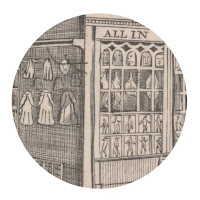Circa 1740s-1874
~Reproduction from the 1870s of John Allin’s business (run from c. 1785-1813), made by his great-grandson Clement Selkirk Jones, on the corner of Ann Street (to the right) and Congreve Street (left). The building on the far right next to the castellated shop is the White Lion public house. The birds in the first floor window were taxidermies and part of a cabinet of curiosities.~
In the middle of Victoria Square, just behind where the statue of Queen Victoria stands, stood an eccentric little shop. They say an Englishman’s home is his castle, and the house that stood here, on the corner of Ann Street and Congreve Street, with its castellated top and tower, topped with the union jack, is definitely John Allin’s castle. It is likely that Allin’s father (or grandfather) built the property, as the family owned it and the three buildings next to it up Ann Street, but it was probably initially only a dwelling house. Allin usually flew the union jack from the roof of his shop and the premises became known simply as ‘The Flag’, and it seems that John was quite a patriot as he also named one of his daughters Caroline Britannia. Allin was a tailor, appearing first in trade directories in 1785 as a habit maker, but he imaginatively developed the business by diversifying his products along with creatively promoting the business.
In 1803 he produced a booklet advertising his shop in a series of poems. These show that as well as new and second hand clothes, hats, linen and hosiery he also sold toys for children, puzzling cards, amusing cards and spelling books, art materials, sheet music and instruments, stationary and educational material, maps and travel charts and medicines including an amazing ‘cure all’ balm. He might also play his clarinet whilst you were perusing in his shop. And this was not all; he would soak your feet to clear them of corns, and pull your rotten teeth! The Latin phrase that is written on the shop in the advert (above) is ‘Multum in Parvo’ which means ‘much in little’, or ‘much in a small place’, which could not be truer. You can just imagine browsing through the shop, which would be jam-packed with all number of surprising objects (click here to view some possible items); and then of course you could go upstairs for a shilling and look at the Cabinet of Curiosities.
The Cabinet consisted of all sorts of items that would have amazed those in the late 18th century as there was a definite culture of curiosity. Travel was prohibitively expensive and much of the world had yet to even be explored, so collections filled with natural history objects and items from around the globe were particularly popular. In Allin’s cabinet there were taxidermied animals; ‘birds of all kinds and beasts of rare creation’ and in the image above there are two birds on the window ledge of the first floor window. Also on display were ‘shells, medals [and] foreign coins from every nation’, and Allin had his own coin struck advertising his shop and his miniature panorama. The scenes in his panorama changed on alternate days, unlike the full scale panorama nearby on New Street, which changed, usually, monthly. He also boasts of a 'crooked telescope that views straight', a mirror that distorts the image and a model of the solar system. Visitors could also get their portraits sketched by a young employee.
~A close-up of the advert John Allin produced to promote his business showing Allin's window display. You can see the images of the fashionable dress of the time, clothes hung on pegs outside, and what could be mannequins inside the window. Examples of his clothes can also be seen hung on pegs outside.~
In the late 1800s Allin extended his business to larger premises in High Street and left the Ann Street shop in charge of his son William. When John died in 1813 William moved permanently to High Street, which took with it the name ‘The Flag’, but because the family owned the property in Ann Street they rented it out. The next known usage was as a chemist’s, run by Samuel Wilson Suffield.
Further information.
References available on request.
To find out more click on the labels below.
Any questions? Please use the comments section below.


